Overview
FLUids, rEduction, Nonlinearity, and Turbulence (FLUENT) group focuses on reduced-order modeling and analysis of fluid flows using various tools including control theory, nonlinear dynamical systems, and optimization. The fluids problem arises from various applications including aerospace engineering, naval and ocean engineering, atmosphere, and physical oceanography.

A key focus of our group’s research reduced-order models with different level of nonlinearity for various flow configurations. The reduced order modeling can be achieved by including more nonlinear effects into linear analysis framework, or performing model reduction from full equations.
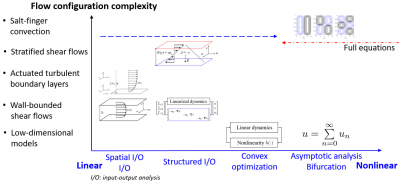
Structured input-output analysis of wall-bounded shear flows
This direction proposes structured input-output analysis that develops a feedback interconnection (figure below) to includes nonlinear effect within input-output analysis framework. This framework leverages structured singular value computation from robust control theory.

Structured input-output analysis includes componentwise structure of nonlinearity that was shown to weaken the lift-up mechanism in wall-bounded shear flows. The structured input-output analysis identifies streamwise dependent structures close to nonlinear optimal perturbation, while traditional input-output analysis is dominanted by streamwise elongated structures close to linear optimal perturbations.
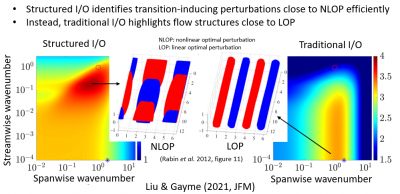
Framework development:
- Chang Liu, Dennice F. Gayme (2021) “Structured input–output analysis of transitional wall-bounded flows.” Journal of Fluid Mechanics. 927, A25. https://doi.org/10.1017/jfm.2021.762
- Chang Liu, Yu Shuai, Aishwarya Rath, Dennice F. Gayme (2023) “A structured input-output approach to characterizing optimal perturbations in wall-bounded shear flows.” 2023 American Control Conference (ACC). https://ieeexplore.ieee.org/document/10156058
Applications:
- Chang Liu, Colm-cille P. Caulfield, Dennice F. Gayme (2022) “Structured input-output analysis of stably stratified plane Couette flow.” Journal of Fluid Mechanics. 948, A10. https://doi.org/10.1017/jfm.2022.648
- Yu Shuai, Chang Liu, Dennice F. Gayme (2023) “Structured Input-Output Analysis of Oblique Laminar-Turbulent Patterns in plane Couette-Poiseuille Flow.” International Journal of Heat and Fluid Flow. 103, 109207. https://doi.org/10.1016/j.ijheatfluidflow.2023.109207
- Yu Shuai, Chang Liu, Dennice F. Gayme (2022) “Structured Input-Output Analysis of Oblique Turbulent Bands in Transitional Plane Couette-Poiseuille Flow.” Proceedings of the Twelfth International Symposium on Turbulence and Shear Flow Phenomenon. http://www.tsfp-conference.org/proceedings/2022/254.pdf
Bifurcation analysis and reduced-order modeling of double-diffusive convections
This direction performs bifurcations analysis including computing nonlinear solutions by numerical continuation and analyzing the stability of these solutions. The application is focused on double-diffusive convection, including both salt-finger regime (hot salty fluids on top of cold fresh fluids) as well as diffusive regime (cold fresh fluids on top of hot salty fluids). The figure below shows one bifurcation diagram for vertically confined salt-finger convection, where S1, S2, and S3 displays staircase like structure resembling oceanographic observations.
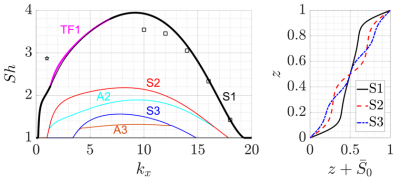
In order to speedup the bifurcation analysis, single-mode equations are employed that severely truncate the horizontal Fourier mode into a single mode. This type of model is especially suitable for flow structures dominanted by well-organized columnar structures due to the existence of large-scale damping, which exists in both salt-finger convection and convection in a porous medium. Figure below shows a comparison of solution profile between single-mode solutions and direct numerical simulations (DNS) for convection in a porous medium.
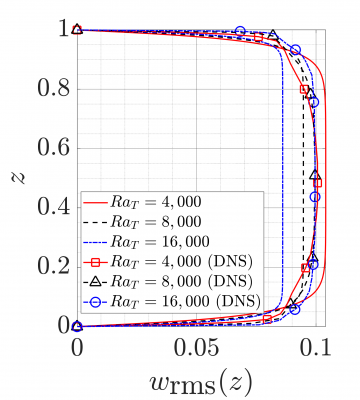
- Chang Liu, Keith Julien, Edgar Knobloch (2022) “Staircase solutions and stability in vertically confined salt-finger convection.” Journal of Fluid Mechanics. 952, A4. https://doi.org/10.1017/jfm.2022.865
- Chang Liu, Edgar Knobloch (2022) “Single-mode solutions for convection and double-diffusive convection in porous media.” Fluids. 7, 373. https://doi.org/10.3390/fluids7120373
Spatial input-output analysis of turbulent boundary layers
This direction formulates spatial input-output analysis, which is spatial marching in streamwise direction, while temporal domain is Fourier transformed into frequency domain. This is in particular suitable to consider the spatial developing effect. Figure below shows a comparison between experimental results (top row) and spatial input-output analysis (bottom row). The spatial input-output analysis is able to capture the downstream evolution effect in turbulent boundary layer flows.

- Chang Liu, Igal Gluzman, Mitchell Lozier, Samaresh Midya, Stanislav Gordeyev, Flint O Thomas, Dennice F Gayme (2022) “Spatial input–output analysis of actuated turbulent boundary layers.” AIAA Journal. 60, 6313–6327. https://doi.org/10.2514/1.J061706
- Chang Liu, Igal Gluzman, Mitchell Lozier, Samaresh Midya, Stanislav Gordeyev, Flint O Thomas, Dennice F Gayme (2021) “Spatial input–output analysis of large-scale structures in actuated turbulent boundary layers.” AIAA Aviation. https://doi.org/10.2514/6.2021-2873
Convex optimization based nonlinear stability analysis in shear flow
The idea of this work is to that any quadratic nonlinear function can be upper bounded by the absolute value of a linear function in a local region. This upper bound may be different in different local region, (see red and blue lines in figure below). After obtaining this upper bound, we can compute the region of attraction of a nonlinear system using convex optimization formulation; such as linear matrix inequality. More detail this upper bound is containing, less conservative of the estimation of region of attraction. This work actually motivates the structured input-output analysis, which is formulated in a more elegant fashion allowing direct applications in Navier-Stokes equations.

- Chang Liu, Dennice F Gayme (2020) “Input-output inspired method for permissible perturbation amplitude of transitional wall-bounded shear flows.” Physical Review E. 102, 063108. https://doi.org/10.1103/PhysRevE.102.063108
Input-output based analysis of convective velocity of turbulent channel flow
This work employs input-output analysis to analyze convective velocity in turbulent channel flows. We also take the computational efficiency of input-output analysis to isolate different linear mechanism, and identify that the viscous term plays an important role of large-scale convective velocity near the wall. A viscous correction of Taylor’s hypothesis is proposed.
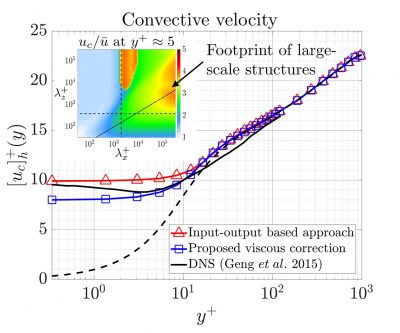
- Chang Liu, Dennice F. Gayme (2020) “An input-output based analysis of convective velocity in turbulent channels.” Journal of Fluid Mechanics. 888, A32. https://doi.org/10.1017/jfm.2020.48
- Chang Liu, Dennice F Gayme (2019) “Convective velocities of vorticity fluctuations in turbulent channel flows: an input-output approach.” Proceedings of the Eleventh International Symposium on Turbulence and Shear Flow Phenomenon, Southampton, UK. http://www.tsfp-conference.org/proceedings/2019/307.pdf
Semi-analytical solutions of shallow water waves
This direction employs Adomian decomposition method (ADM) to compute semi-analytical solutions within shallow water waves without and with bottom friction. This further allows the development of closed-form solutions including inertial geostrophic oscillation as well as anticyclonic vortices with finite escape time. Introducing of bottom friction leads to these nonlinear solutions to be growing, which is a phenomenon of dissipation-induced instability.
- Chang Liu, Antwan D. Clark (2023) “Semi-Analytical Solutions of Shallow Water Waves with Idealised Bottom Topographies.” Geophysical & Astrophysical Fluid Dynamics. 117, 35–58. https://doi.org/10.1080/03091929.2023.2169283
- Chang Liu, Antwan D. Clark (2023) “Analysing the impact of bottom friction on shallow water waves over idealised bottom topographies.” Geophysical & Astrophysical Fluid Dynamics. 117, 107–129. https://doi.org/10.1080/03091929.2023.2204430
Time-varying hydrodynamics identification in vortex-induced vibrations
This direction employs forgetting-factor least squares method (see figure below shoing the date weight and a comparison with ordinary least squares method) to identify time-varying hydrodynamic coefficients for flexible pipe under vortex-induced vibrations. It reveals the correlation between excitation coefficient and time derivative of displacement amplitude.

This method is employed for a wide range of experimental dataset, including flexible pipe under uniform flow, shear flow, oscillatory flow and steel catenary riser.
- Chang Liu, Shixiao Fu, Mengmeng Zhang, Haojie Ren, Yuwang Xu (2020) “Hydrodynamics of a flexible cylinder under modulated vortex-induced vibrations.” Journal of Fluids and Structures. 94, 102913. https://doi.org/10.1016/j.jfluidstructs.2020.102913
- Chang Liu, Shixiao Fu, Mengmeng Zhang, Haojie Ren (2018) “Time-varying hydrodynamics of a flexible riser under multi-frequency vortex-induced vibrations.” Journal of Fluids and Structures. 80, 217–244. https://doi.org/10.1016/j.jfluidstructs.2018.03.004
- Mengmeng Zhang, Shixiao Fu, Chang Liu, Haojie Ren, Yuwang Xu (2021) “Experimental investigation on vortex-induced force of a steel catenary riser under in-plane vessel motion.” Marine Structures. 78, 102882. https://doi.org/10.1016/j.marstruc.2020.102882
- Chang Liu, Shixiao Fu, Mengmeng Zhang, Haojie Ren (2017) “Time Varying Hydrodynamics Identification of a Flexible Riser Under Multi-Frequency Vortex-Induced Vibrations.” International Conference on Offshore Mechanics and Arctic Engineering. 57649, V002T08A029. https://doi.org/10.1115/OMAE2017-61261